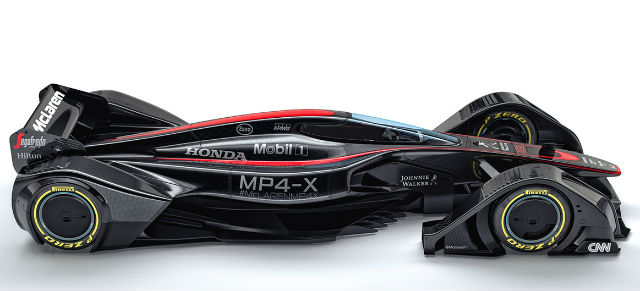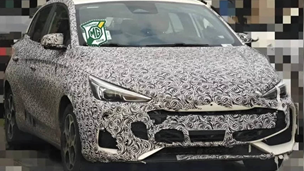McLaren has offered an awe-inspiring and slightly alarming glimpse at the Formula One cars of the future, with its radical new MP4-X concept.
Designed to showcase the ability of the marque’s Applied Technologies division to master advanced technologies, the MP4-X is a veritable clusterjam of tech that seems ripped straight from a sci-fi movie.
As well as boasting a protective canopy, it comes with a shape-shifting chassis that can recover its original shape after impact. It also has an augmented reality HUD that projects driver information and sensors to monitor the driver’s health.
Jim Newton, marketing development director for McLaren Applied Technologies, said: “Clearly all the things we have highlighted on the vehicle are not fully resolved solutions today, but this wasn't the brief - it was to look beyond into a possible future.”

In truth, however, McLaren is already using some of the technology on the MP4-X today, for example battery packs that are a structural element in the bodywork. Outside of cars, McLaren has also used its health sensors and instruments to monitor the fitness of rugby union teams.
The most exciting part of McLaren’s new concept, however, is that it’s designed to be able to monitor and interpret brain activity from the driver. That means the car can accept thought commands from its pilot.
Working in partnership with GlaxoSmithKline, McLaren has been investing large amounts of time and money into understanding neurological diseases like Amyotrophic Lateral Sclerosis.
“Universities and companies are now able to understand brain patterns to an increasingly detailed level and then use this as a guide to understanding how people are thinking and behaving – this is a really interesting area,” Newton says.

Development of this technology could enable drivers to control the car and its systems using nothing other than their thoughts alone, while their race team could effectively read the driver’s mind.
“As a tactician and strategist, to know what's on the driver's mind at that time might help you in more tactical thinking, and then help you to optimise how you communicate with the driver,” Newton added.
“There's a reason that drivers mostly communicate on the straights, they're busy in the corners. So to understand to some degree what the driver was thinking without having to communicate verbally may be a considerable advantage.”
With its canopy, the car isn’t just safer and more aerodynamic, but McLaren also designed the roof to be hydrophobic and photochromatic, adapting itself to different lighting or weather conditions. In clear weather, it could become transparent to let the viewing public see the driver inside, while it could also darken under intense sunlight to improve its pilot’s visibility or resist water during rainfall.
Other futuristic embellishments include the addition of Active Flow Control, which is an already established aerodynamic concept, and which uses electrodes fitted to the surface of the cars wings. When switched on, the electrodes can turn the air around the car to plasma in order to reduce drag friction, increasing airflow over the wings to offer much more downforce and grip when cornering.
“Plasma flow control would require quite a lot of power, but, in the future, we could take power from the engine and divert it to charge the system,” said Geoff McGrath, chief innovation officer for the Applied Technologies division.
“It's banned in the current F1 regulations but it's great for achieving high top speeds, particularly at circuits like Monza, where you want to shed all the downforce along the straights and then turn it back on again for the corners.”
McLaren’s designers also added ultra-lightweight solar panels to the concept in order to provide power for the on-board systems or to divert extra power to the wheels via electric generators for a quick speed boost.

Alongside that, the MP4-X also has adaptive aerodynamic structures to change shape as an electrical current passes through them. It also sports a completely digital marketing skin, which eschews traditional stickers in favour of digital logos downloaded onto the car’s surface.
Of course, McLaren realises that there are a good many technologies present on the new concept which are still quite far off. Nonetheless, several new pieces present on the MP4-X could be ready for real-world use sooner rather than later.
In particular, Newton reckons that the concept’s tyre de-lamination sensor, which can predict when the tyres will wear out, is one such piece of kit that could be making its way into cars in the near future.
“It is an exemplar of the application of real-time analytics to aid decision making in the moment,” Newton says. “An example of the sorts of things we are doing in oil and gas drilling, where we are providing real-time predictive analytics to real-time drilling in the North Sea.”

Radial tyres are constructed by laying steel belts between layers of rubber and composite. Each layer forms a ply, and these plies are laminated to one another when the tyre is created. If the belts become warm enough, they can separate from one another, meaning that a change is necessary before the tyres jeopardise performance, lap times and potentially the safety of the driver.
Through use of real-time sensing and the generation of usable insight using predictive analytics systems, racing performance could be significantly boosted, and the potential for carry-over into other cars and industries is huge.
“These activities involve the real-time sensing and generation of usable insight using predictive analytics to drive optimal decision making - this is very exciting as a concept in general,” Newton said.
According to McLaren, the one other piece of technology that has got its engineers excited is the tremendous advancements in battery technology, which it says can be applied to more than just racing cars.

“The power densities were are able to achieve are genuinely world leading in any industry,” Newton said. “We are already seeing opportunities to apply these battery and hybrid technologies in diverse industries such as aerospace, and significantly change how those industries operate.”
Anything else? Well, if all of this sounds like an incredibly impressive glimpse at the cars of the future, it’s worth thinking about what sorts of neat tricks McLaren is keeping hidden up its sleeves for the time being.
“There are certainly technologies we haven't used on the MP4-X, ones that are just too exciting to share,” Newton said. Blimey, colour us excited.



